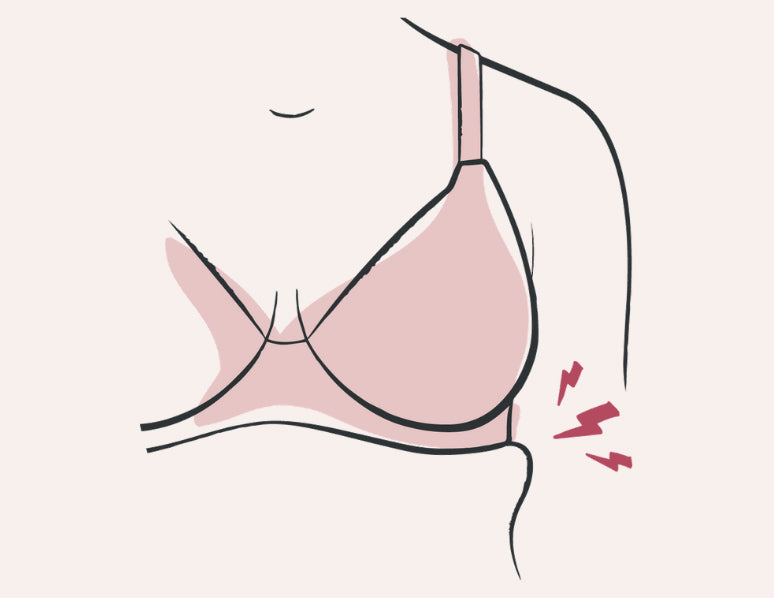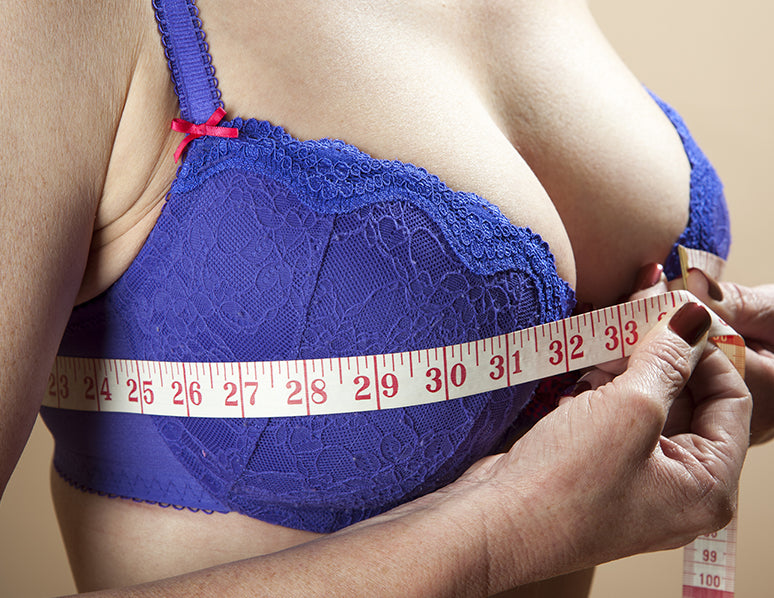We know, a bra isn’t always thought of as the most comfortable thing in the world.
From underwire that pinches to straps that leave red marks, for many women the thing they love the most about their bra is when they get to take it off. It shouldn’t be this way!

A bra should be supportive, comfortable, and feel like it was made just for you. You may not realize it, but the band is the most important part of the bra when it comes to support. It holds about 80 percent of your breast’s weight and acts as an anchor.
When you’re wearing the wrong style or size bra band it can cause a number of problems. Let’s take a look at one all too common bra complaint: a painful bra band.
Why does my bra band hurt?
Bra bands usually cause pain when the bra is too small. This can be caused by the band itself being too small, the cups being too small or a combination of the two.
One thing is certain if your bra band is causing you pain, something is wrong. Your band should be snug enough to provide support but if it leaves you with red marks or makes it uncomfortable to move around or breathe you definitely need to reassess things.
Not only is a too-tight bra band uncomfortable, but it’s also not as functional as one that fits properly. In addition, it can be extremely unflattering, leaving bumps and rolls.
You can learn more about why bra bands hurt in our 5 Bra Mistakes guide.
How tight should your bra band be?
Unless it’s digging in quite a bit it can be hard to tell if your bra band is too tight or tight enough. In order for a bra to be as functional as possible, the fit should be as precise as possible. Here’s a quick test that you can do right now to see if your band fits you well.
Place a finger underneath your band. If more than one finger fits it’s too loose, and if you can’t fit a finger underneath it’s too tight. If you can fit one finger comfortably underneath your band it’s just loose enough.
Make sure that the band is parallel to the floor all the way around. If it’s up too high or too low in the back adjust the straps.
What do I do if my bra band is too small?
If you’ve discovered that your band is too small you’ll have to move up at least a size. The best thing to do is to re-measure yourself. This way you’re not wasting time with another potential bad fit. Start by getting a tape measure.
It’s best to measure without a bra but if you do wear one make sure it’s unlined or very lightly lined. Measure your chest using a tape measure. Wrap the tape around yourself right underneath your arms and at the top of your bust. Round up to the nearest number. This is your band size.
Make sure that when you measure that the tape measure is parallel to the ground. To measure your cup size, measure across the fullest part of your bust. Now take the difference between the two measurements. One inch is an A cup, 2 inches a B cup, 3 inches a C cup, and so on.
Why is my bra band riding up?
Aside from an ill-fitting band, another common problem is a band that will not stay put. If your band ends up closer to your neck than your ribs as the day goes on your band is most likely too loose.
Your breasts can weigh more than you think, up to a couple of pounds each! If your band isn’t tight enough the weight of your breasts will cause the back of your band to ride up. This isn’t just annoying; it also means that your bra isn’t able to give you the lift that you’re looking for.
If your band is riding up, also check to see if your straps are too tight. If your band fits correctly you don’t need to tighten the straps all of the way. If your straps are too short they’ll not only dig in but they may start pulling your band up in the back.

What type of bra band is right for me?
Once you find the correct bra size you’ll need to make sure that you have to correct style. Bra bands can be thin, with one row of hooks, or they can be wide with three or more rows. The thinner the band is the less support it will give.
A thin band is fine for smaller cup sizes, but for those that are C and above, go for a wider band. A thin band is also more likely to dig in and create unflattering bumps. If you’re worried about a smooth look rather than sacrificing support by wearing a band that’s too loose look for a band created to help smooth the back.
This is especially important with strapless bras. In strapless styles, the band is doing all of the work, so it’s crucial to make sure that your band fits properly.
When it comes to finding the bra of your dreams, making sure that you have the correct bra size is the first step. If support is what you’re looking for, checking to see if your band fits properly is extremely important.
Also, when it comes to buying a bra, quality cannot be overemphasized. Even if it’s your perfect size if it’s not made of high-quality materials it will wear out unevenly and faster than it should.
Should I Reduce My Bra Band or Cup Size?
If your bra cup is too big, but the band still fits, then you should size down in the bra cups to eliminate cup gapping. If your bra band is riding up, then you are likely wearing the wrong bra size and need to size down in the band size. The bra band provides the majority of the support, so it should fit snugly without moving around too much.
Why Does Cup Size Typically Increase With Band Size?
It's a common misconception that bra cup size remains constant along with band size, but this isn't the case. Cup volume increases along with bra band size. For example, bra size 36D has larger cup volume than size 34D. So if you normally wear size 34D, the equivalent bra cup volume will be size 36C.
Is There Anything You Can Do to Make Your Bra Cups Fit Better If the Band Still Fits?
If your bra band fits you, but the cups are too big, try a smaller cup size with the same band size. Alternatively, you can try tightening the bra straps. The fabric of the bra cups can stretch out over time, which can cause some gapping on the top, so this should only be a temporary fix until you can get a new bra with the proper bra cup size. Wearing the right bra size is crucial to getting the support and comfort you need. An ill-fitting band or cup size can do more harm than good, and will likely not provide enough support.
Related Articles
Lift, Shape, and Support With Comfort and Style



